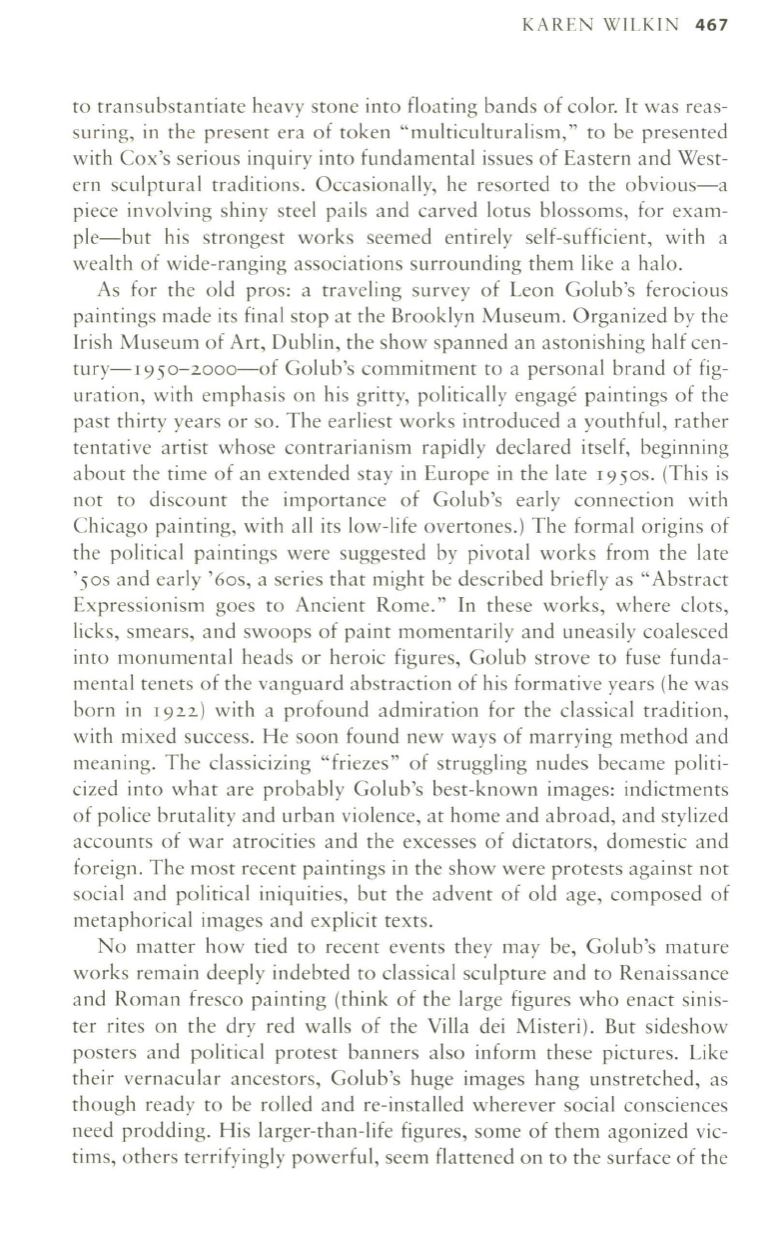
KAREN WILKIN
467
to transubstantiate heavy stone into floating bands of color.
It
was reas–
suring, in the present era of token "multiculturalism," to be presented
with Cox's serious inquiry into fundamental issues of Eastern and West–
ern sculptural traditions. Occasionally, he resorted to the obvious-a
piece involving shiny steel pails and carved lotus blossoms, for exam–
ple-but his strongest works seemed entirely self-sufficient, with a
wealth of wide-ranging associations surrounding them like a halo.
As for the old pros: a traveling survey of Leon Golub's ferocious
paintings made its final stop at the Brooklyn Museum. Organized by the
Irish Museum of Art, Dublin, the show spanned an astonishing half cen–
turY-1950-2000-of Golub's commitment to a personal brand of fig–
uration, with emphasis on his gritty, politically engage paintings of the
past thirty years or so. The earliest works introduced a youthful, rather
tentative artist whose contrarianism rapidly declared itself, beginning
about the time of an extended stay in Europe in the late I950s. (This is
not to discount the importance of Golub's early connection with
Chicago painting, with all its low-life overtones.) The formal origins of
the political paintings were suggested by pivotal works from the late
'50S and early '60S, a series that might be described briefly as "Abstract
Expressionism goes to Ancient Rome."
In
these works, where clots,
licks, smears, and swoops of paint momentarily and uneasily coalesced
into monumental heads or heroic figures, Golub strove to fuse funda–
mental tenets of the vanguard abstraction of his formative years (he was
born in
J
922) with a profound admiration for the classical tradition,
with mixed success. He soon found new ways of marrying method and
meaning. The classicizing "friezes" of struggling nudes became politi–
cized into what are probably Golub's best-known images: indictments
of police brutality and urban violence, at home and abroad, and stylized
accounts of war atrocities and the excesses of dictators, domestic and
foreign. The most recent paintings in the show were protests against not
social and political iniquities, but the advent of old age, composed of
metaphorical images and explicit texts.
No matter how tied to recent events they may be, Golub's mature
works remain deeply indebted to classical sculpture and to Renaissance
and Roman fresco painting (think of the large figures who enact sinis–
ter rites on the dry red walls of the Villa dei Misteri). But sideshow
posters and political protest banners also inform these pictures. Like
their vernacular ancestors, Golub's huge images hang unstretched, as
though ready to be rolled and re-installed wherever social consciences
need prodding. His larger-than-life figures, some of them agonized vic–
tims, others terrifyingly powerful, seem flattened on to the surface of the


